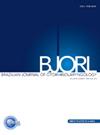Clinicopathological analysis of hyalinizing clear cell carcinoma in the head and neck
IF 1.8
4区 医学
Q2 OTORHINOLARYNGOLOGY
引用次数: 0
Abstract
Objective
To study clinicopathological features and differential diagnosis of hyalinizing clear cell carcinoma in the head and neck.
Methods
A retrospective analysis was performed patients with hyalinizing clear cell carcinoma in the head and neck, who underwent surgical resection in Beijing Tongren Hospital affiliated to Capital Medical University from January 2014 to May 2024. The clinical features of HCCC were analyzed by computed tomography and magnetic resonance imaging. Tumor sections were further characterized using hematoxylin and eosin staining, immunohistochemistry, and fluorescence in situ hybridization.
Results
There were 4 male and 5 female cases in 9 patients. The age range was 28–84 years-old, the middle age was 60 years-old. 9 patients, 5 in the nasopharynx, 2 in the base of the tongue, and 2 in the oropharynx. At the cellular level, the HCCC tumors were composed of transparent and eosinophilic cells (in various ratios), which were typically arranged into nests, cords, and trabeculae, and embedded in a glassy hyaline substance. Immunohistochemical evaluation showed positivity for CK7, P63, P40, CK5/6, and negativity for S100, SMA, GFAP, and calponin. Fluorescence in situ hybridization revealed EWSR1 rearrangement in all the nine patients evaluated.
Conclusions
Hyalinizing clear cell carcinoma is a rare low-grade salivary gland carcinoma that mostly occurs in the minor salivary glands. They had an indolent disease course, with few metastases. Our study shows that the above combination of analytical techniques can be used to accurately characterize and diagnose HCCC.
Level of evidence
Level 1.
头颈部透明细胞癌的临床病理分析
目的探讨头颈部透明细胞癌的临床病理特点及鉴别诊断。方法回顾性分析2014年1月至2024年5月在首都医科大学附属北京同仁医院行手术切除的头颈部透明细胞癌患者。通过计算机断层扫描和磁共振成像分析HCCC的临床特征。肿瘤切片采用苏木精和伊红染色、免疫组织化学和荧光原位杂交进一步表征。结果9例患者中男4例,女5例。年龄范围为28-84岁,中年为60岁。9例,鼻咽部5例,舌底2例,口咽部2例。在细胞水平上,HCCC肿瘤由不同比例的透明和嗜酸性细胞组成,典型排列成巢状、索状和小梁状,包埋在玻璃状透明物质中。免疫组化评价显示CK7、P63、P40、CK5/6呈阳性,S100、SMA、GFAP和钙钙蛋白呈阴性。荧光原位杂交显示所有9例患者的EWSR1重排。结论涎化透明细胞癌是一种罕见的低级别唾液腺癌,多发生在小唾液腺。他们的病程缓慢,很少有转移。我们的研究表明,上述分析技术的组合可以用来准确地表征和诊断HCCC。证据等级:1级。
本文章由计算机程序翻译,如有差异,请以英文原文为准。
求助全文
约1分钟内获得全文
求助全文
来源期刊

Brazilian Journal of Otorhinolaryngology
OTORHINOLARYNGOLOGY-
CiteScore
3.00
自引率
0.00%
发文量
205
审稿时长
4-8 weeks
期刊介绍:
Brazilian Journal of Otorhinolaryngology publishes original contributions in otolaryngology and the associated areas (cranio-maxillo-facial surgery and phoniatrics). The aim of this journal is the national and international divulgation of the scientific production interesting to the otolaryngology, as well as the discussion, in editorials, of subjects of scientific, academic and professional relevance.
The Brazilian Journal of Otorhinolaryngology is born from the Revista Brasileira de Otorrinolaringologia, of which it is the English version, created and indexed by MEDLINE in 2005. It is the official scientific publication of the Brazilian Association of Otolaryngology and Cervicofacial Surgery. Its abbreviated title is Braz J Otorhinolaryngol., which should be used in bibliographies, footnotes and bibliographical references and strips.
 求助内容:
求助内容: 应助结果提醒方式:
应助结果提醒方式:


